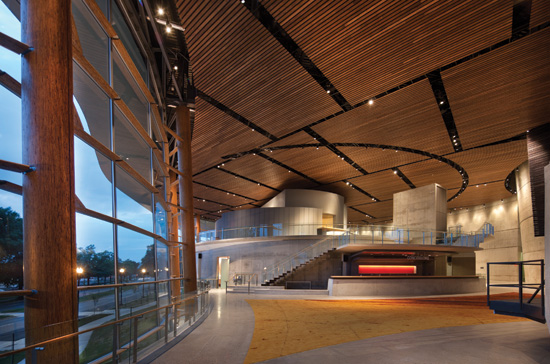Wood and Indoor Environment
Sound of Wood
Architect Marcy Wong, whose firm Marcy Wong Donn Logan Architects frequently uses wood for its acoustic properties, articulates the connection between acoustics and sustainability in this way: “In addition to the usual sustainable advantages of wood—renewability, nontoxic, carbon storing—there is an additional aspect, that being acoustics. Sustainability is more than being responsible about the impact of a project on the earth's resources and climate, but also on the quality of environment for users.”
For centuries, wood has been the material of choice for architects and designers intent on delivering the highest quality acoustic performance. From a violin to a concert hall, wood plays a role in delivering memorable acoustic experiences. Wood produces sound by direct striking and it amplifies or absorbs sound waves that originate from other bodies. For these reasons, wood is an ideal material for musical instruments and other acoustic applications, including architectural ones.
Wood is not as “acoustically lively” (translation: noisy) as other surfaces. Post-occupancy evaluations of buildings have revealed that poor acoustic performance is a common problem in buildings with large areas of hard, acoustically reflective surfaces. Ironically, such surfaces are frequently found in buildings designed to be sustainable, where the use of absorbent materials is minimized due to indoor air quality concerns.
In large buildings with hundreds or even thousands of occupants—for example, apartment buildings, condominiums, hotels or dormitories—every acoustic detail has a positive or negative effect on the quality of daily life. Wood-frame construction is efficient in buildings where sound insulation is required. In particular, wood doesn't present the impact noise transmission issues commonly associated with other types of construction.
University of Washington
In 2012, the University of Washington in Seattle added nearly 1,700 student housing beds by constructing three residential halls and two apartment buildings, all of which include five stories of wood-frame construction over two stories of concrete. Designed by Mahlum Architects and winner of a WoodWorks Wood Design Award, the 668,800-square-foot project is the first of four phases planned to add much-needed student housing to the urban campus.

Photo by Nic Lehoux, courtesy of Bing Thom Architects
Arena Stage at the Mead Center for American Theater
Washington, D.C.
Bing Thom Architects
“Acoustics are important for any multifamily housing project, but especially for student housing,” says Anne Schopf, FAIA, a design partner with Mahlum. “Mitigation measures must be weighed against budget, which is why we brought in experts from Seattle-based SSA Acoustics for the design of this project.”
Because they knew single stud walls would not provide adequate performance, SSA recommended staggered stud walls between residential units. Since there is no rigid connection between the gypsum board on each side (except at the plate), a staggered stud wall performs better than a single stud wall. Double stud walls perform better than a staggered stud design because plates are separated by an air space, so they used double stud walls between residential units and common spaces (e.g., lounges, staircases, and elevators) and service areas.
In the floor/ceiling assembly, they paid careful attention to the installation of resilient channels, which are often one of the main causes of failed floor/ceiling assemblies from an acoustical standpoint. In fact, SSA says there's a difference of 8 to 10 IIC and STC points between assemblies with resilient channels versus those without. Channel installation has fairly straightforward requirements; for example, screws for the gypsum board should never touch the framing behind the resilient channel.
“We used enhanced acoustical walls between rooms in the same unit,” says Mohamed Ait Allaoua, a managing partner at SSA. “Although not a typical approach in multifamily buildings, this is important in student housing projects where people within a relatively small space have different needs—if one student wants to watch TV in the living room, for example, while another is studying in the bedroom.”









